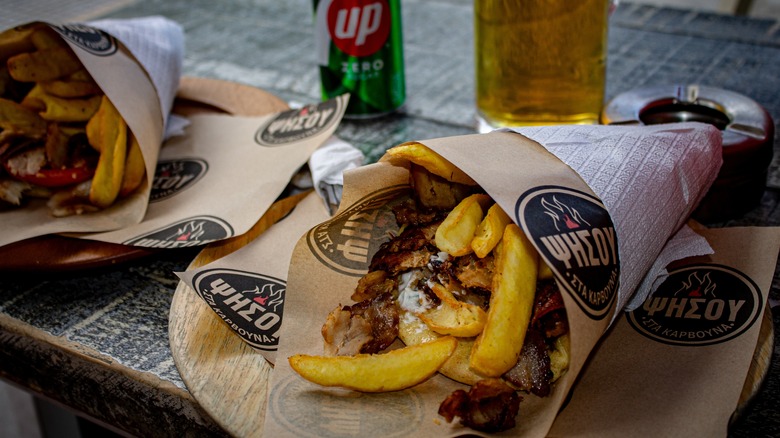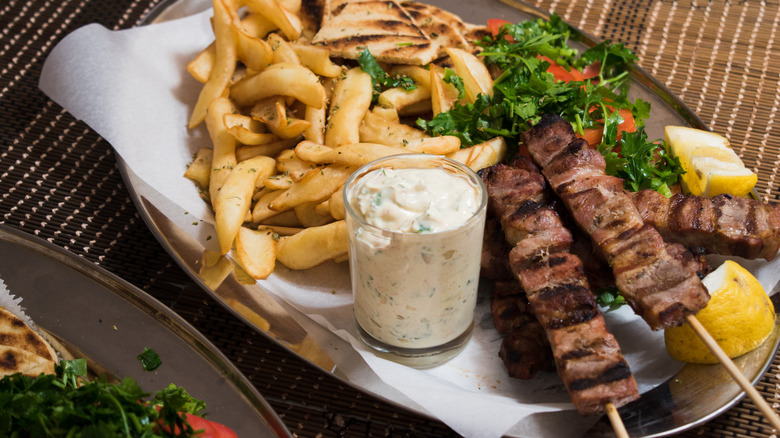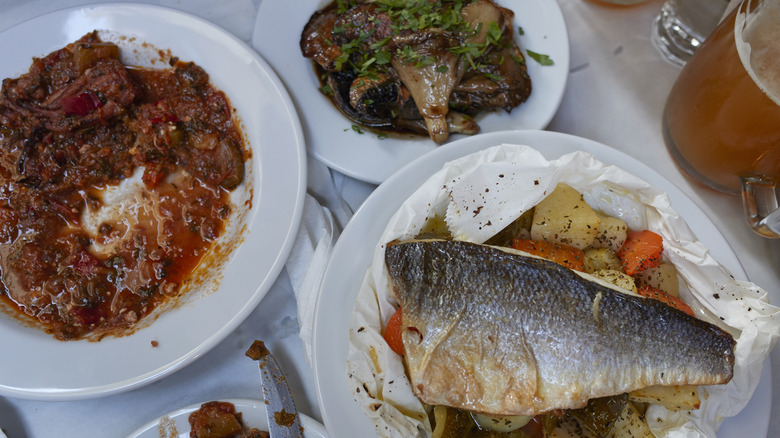The Biggest And Most Unexpected Food Mistake Tourists Make While In Greece
Travel fads come and go but Greece is always a perennial favorite for holidaymakers. Greek tourism dates back to ancient times and even the risk of disastrous wildfires didn't stop the country welcoming a record number of visitors in 2024. After all, what's not to love? Greece offers an outstanding blend of culture, beaches, island-hopping, and nightlife, making it a terrific all-round destination for just about every traveler on any kind of budget. For foodies, Greek cuisine is one of the undoubted highlights, yet many tourists make one major culinary mistake: eating too many gyros.
Greece is renowned for having some of the best cuisine on the planet, benefitting from an abundance of fresh vegetables, fish, legumes, meat, and dairy products. Many Greek dishes are world-famous, such as hearty and delicious baked moussaka, the national dish of chunky bean soup (fasolada), cooling tzatziki dip, refreshing salads, and some of the finest olives and olive oil available to humanity. Then there is the humble gyros, a hand-held favorite that can be found around the globe and has developed something of a reputation as a go-to option after a night on the town. In Greece, the grilled meat belly-filler is more of an all-day thing, but tucking into too many means you run the risk of missing out on the country's wealth of other culinary delights. Let's take a closer look at the classic street food and a few of the alternatives.
Gyros is one of Greece's most popular street foods
Let's begin by saying that you absolutely should eat gyros on your next trip to Greece. The handheld meal is hugely popular, especially in cities where locals eat them from breakfast to dinner and beyond. Souvlaki refers to meat (usually pork or chicken) cooked on a spit or skewer and can mean either gyros, shaved slices of meat from a rotisserie; kalamaki, meat cubes grilled on a skewer; and kebab, minced meat on a skewer. Some confusion may also arise for visitors because Greeks often use the term "souvlaki" interchangeably for all three.
Greeks have been grilling meat on skewers for thousands of years but gyros is a relatively new addition to the street food scene, arriving from Turkey during the Greco-Turkish war in the 1920s. If you visit a classic souvlaki joint like Achilleas in Athens, typical gyros is served in a fluffy pita with onions and fresh tomatoes. There is some debate about whether the addition of tzatziki and/or french fries distracts from the flavor of juicy grilled meat, but they are both very common options. To make the proposition even more attractive, gyros from a hole-in-the-wall vendor is cheap, usually only costing a few Euros. Souvlaki is also a mainstay on restaurant and hotel menus, often served as a platter with french fries, salad, and tzatziki. Its allure and ubiquity is so strong that many visitors to the country end up eating it for most meals during their trip.
Delicious Greek alternatives to gyros
For your first meal of the day, skip the popular breakfast option of the hotel buffet, swerve the souvlaki stands, and find yourself a plate of strapatsada instead. The dish is a light combination full of sunny Mediterranean flavors thanks to its mix of scrambled eggs, fresh tomatoes, herbs, feta, and olive oil. For lunch and dinner, a sit-down meal in Greece wouldn't be complete without appetizers. Dolmades (stuffed vine leaves) are always a treat but also seek out lahanodomaldes, or cabbage rolls filled with rice and ground beef served with a zesty lemon sauce. Exchange well-known dips like Hummus and Tzatziki for Tirokafteri, a spicy blend of feta cheese, roasted red peppers, and chilis, and swap out standard Greek Salads for Dakos, a Cretan starter that tops barley rusks with chunky fresh tomatoes and feta. Another delicious option is kolokythokeftedes, or lightly fried zucchini fritters.
For your main course at lunch or dinner, tuck into Gemista, baked bell peppers or tomatoes filled with herby rice and sometimes meat. A tasty carnivorous meal that isn't souvlaki is Keftedes, Greek breaded meatballs made from beef or lamb with fresh mint and served with a light yoghurt dip. Tavernas make for a deliciously authentic experience without resorting to souvlaki, and don't sleep on the seafood while dining along the coast. Whole baked fish straight from sea to table is a wonderful treat, and grilled octopus is a popular delicacy across the Greek Islands.


